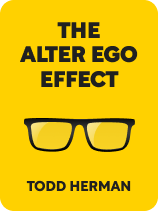

This article is an excerpt from the Shortform book guide to "The Alter Ego Effect" by Todd Herman. Shortform has the world's best summaries and analyses of books you should be reading.
Like this article? Sign up for a free trial here .
Are you your own worst enemy? What forms does your inner nemesis take?
Self-sabotaging comes in three major forms: imposter syndrome, inner wounds, and self-created stories. Todd Herman highlights these destructive patterns in his book The Alter Ego Effect.
Here are the three signs that you are your own worst enemy.
Your Inner Nemesis’ Forms
Now that you’ve set your purpose-driven goals, your next step is to accept that you are your own worst enemy. Todd Herman calls this your inner nemesis. Your inner nemesis is a cluster of negative thoughts and beliefs that keep you from rising to the challenge in high-stakes moments.
(Shortform note: Both Herman and Jen Sincero, author of You Are a Badass, frequently personify mental states and processes. For Herman, your “inner nemesis” consists of negative thoughts, and for Sincero, negative thoughts are created by “the Big Snooze” (the part of you that needs validation to tame your insecurities). Both authors’ use of personification to explain otherwise complicated and unwieldy principles is effective because humans tend to naturally personify things anyway.)
Your inner nemesis can appear in a single form or in a combination of forms to prevent you from doing your best: imposter syndrome, inner wounds, and self-created stories. Let’s look at each.
Form #1: Imposter Syndrome
Imposter syndrome is the belief that your accomplishments are the result of good luck and not your talents, skill, or hard work, asserts Herman. This prevents you from taking yourself and your abilities seriously, which prevents you from trying your hardest in high-stakes moments.
(Shortform note: Imposter syndrome affects certain groups more than others. In Lean In, Sheryl Sandberg contends that women suffer from imposter syndrome more than men. What’s more, while Herman believes imposter syndrome prevents you from trying hard in high-stakes situations, other experts argue that imposter syndrome can also lead you to overachieve to make up for your perceived weaknesses—which could lead to success (though arguably not to contentment).)
Form #2: Inner Wounds
Herman writes that your own worst enemy might reopen inner wounds. This leads you to have repeated unhelpful reactions to high-stakes situations. For instance, if you had a traumatic public speaking experience as a youth, your inner nemesis might reopen that wound in adult public speaking experiences. This makes you nervous, fearful, and unable to do your best.
(Shortform note: Herman contends that adopting an alter ego can help you defeat your inner nemesis and specifically prevent it from reopening inner wounds at inopportune moments. But you can also take other steps to heal the inner wounds that form part of your inner nemesis: Research shows you can reduce the negative emotional impact of an inner wound by re-remembering it as if you were a spectator of the memory, not a subject. The inner wound thus loses much of its ability to derail you at critical moments.)
Form #3: Self-Created Stories
Finally, your inner nemesis might take the form of self-created stories. These are narratives you’ve bought into about what you’re capable of, says Herman. Self-created stories can be narratives you’ve made up about yourself (for example, “I’m terrible at tests”) or narratives members of your family or cohort have created (“Your dad’s side of the family is bad at tests, so you are, too”). These stories usually are limiting and prevent you from achieving your highest potential.
(Shortform note: Herman believes that people create stories about themselves, but it seems that story-creating isn’t confined to the individual. According to Yuval Noah Harari in 21 Lessons for the 21st Century, groups—religious organizations, nations, and political groups—also create stories. Their purpose is to unite a large group of strangers under a shared cause. Like self-created stories, stories created by groups are often incorrect or entirely fake. Their aim is merely to spur action, whether it be to turn against a neighboring nation or, in the case of individual stories, to keep you stuck in safe yet self-defeating patterns of behavior.)

———End of Preview———
Like what you just read? Read the rest of the world's best book summary and analysis of Todd Herman's "The Alter Ego Effect" at Shortform .
Here's what you'll find in our full The Alter Ego Effect summary :
- What an alter ego is and why you should use one
- The steps of building, shaping, and unleashing your alter ego
- Why your alter ego is still authentically you






